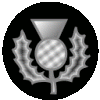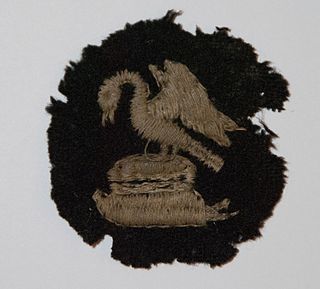Related Research Articles

The 9th (Scottish) Division, was an infantry division of the British Army during the First World War, one of the Kitchener's Army divisions raised from volunteers by Lord Kitchener to serve on the Western Front during the First World War.

The 12th (Eastern) Division was an infantry division raised by the British Army during the First World War from men volunteering for Kitchener's New Armies. The division saw service in the trenches of the Western Front from June 1915 to the end of the war.

The 14th (Light) Division was an infantry division of the British Army, one of the Kitchener's Army divisions raised from volunteers by Lord Kitchener during the First World War. All of its infantry regiments were originally of the fast marching rifle or light infantry regiments, hence the title "Light". It fought on the Western Front for the duration of the First World War.
The division was disbanded by March 1919, and was not reformed in the Second World War.
The 27th Division was an infantry division of the British Army raised during the Great War, formed in late 1914 by combining various Regular Army units that had been acting as garrisons about the British Empire. The division spent most of 1915 on the Western Front in France before moving to Salonika where it remained with the British Salonika Army for the duration of the war. In 1916 its commander Hurdis Ravenshaw was captured by an Austrian submarine whilst sailing to England. In 1918 in Salonika the division took part in the Battle of Doiran. It carried out occupation duties in the Caucasus in the post-war before being withdrawn from the region in 1919.

The 18th (Eastern) Division was an infantry division of the British Army formed in September 1914 during the First World War as part of the K2 Army Group, part of Lord Kitchener's New Armies. From its creation the division trained in England until 25 May 1915 when it landed in France and spent the duration of the First World War in action on the Western Front, becoming one of the elite divisions of the British Army. During the Battle of the Somme in the latter half of 1916, the 18th Division was commanded by Major General Ivor Maxse.

The 34th Division was an infantry division of the British Army that was raised in 1914, during the First World War. The division was raised from volunteers for Lord Kitchener's New Armies, that was originally made up of infantry battalions raised by public subscription or private patronage. The division was taken over by the War Office in September 1915. It served in France and Belgium in the trenches of the Western Front for the duration of the war.

The 46th Division was an infantry division of the British Army, part of the Territorial Force, that saw service in the First World War. At the outbreak of the war, the 46th Division was commanded by Major-General Hon. E.J. Montagu-Stuart-Wortley. Originally called the North Midland Division, it was redesignated as the 46th Division in May 1915.

The 21st Division was an infantry division of the British Army during World War I, raised in September 1914 by men volunteering for Lord Kitchener's New Armies. The division moved to France in September 1915 and served on the Western Front for the duration of the First World War. The divisional insignia was the "triple-seven".

The British 30th Division was a New Army division that was originally made up of battalions raised by public subscription or private patronage. The division was taken over by the British War Office in August 1915 and moved to France in December. It served on the Western Front for the duration of the First World War.

The 32nd Division was an infantry division of the British Army that was raised in 1914, during the First World War. The division was raised from volunteers for Lord Kitchener's New Armies, made up of infantry 'Pals battalions' and artillery brigades raised by public subscription or private patronage. The division was taken over by the War Office in September 1915. It served in France and Belgium in the trenches of the Western Front for the duration of the war. It saw action at the Battle of the Somme, the Pursuit to the Hindenburg Line, the Defence of Nieuport, the German spring offensive, and the Allied Hundred Days Offensive beginning at the Battle of Amiens. After the Armistice it marched into Germany as part of the Army of Occupation.

The 19th (Western) Division was an infantry division of the British Army, part of Kitchener's Army, formed in the Great War.

The 33rd Division was an infantry division of the British Army that was raised in 1914, during the First World War. The division was raised from volunteers for Lord Kitchener's New Armies, that was originally made up of infantry battalions raised by public subscription or private patronage. The division was taken over by the War Office in September 1915. It served in France and Belgium in the trenches of the Western Front for the duration of the war. The division's insignia was the "double-three" from a set of dominoes.
The 22nd Division was an infantry division of the British Army during World War I, raised in September 1914, from men volunteering for Lord Kitchener's New Armies. The division moved to France in September 1915, but it was transferred to Greece only one month later. It served in the Balkans Campaign for the duration of the First World War.
The 28th Division was an infantry division of the British Army raised for service in World War I.
The 25th Division was an infantry division of the British Army, raised as part of Lord Kitchener's Third New Army (K3) in September 1914, shortly after the outbreak of the Great War. It served on the Western Front for most of the war.

The 37th Division was an infantry division of the British Army, raised during the First World War. The divisional symbol was a gold horseshoe, open end up.

The 59th Division was an infantry division of the British Army during World War I. It was formed in late 1914/early 1915 as a 2nd Line Territorial Force formation raised as a duplicate of the 46th Division. After training in the United Kingdom and saw service in the Easter Rising in April 1916, the division joined the British Expeditionary Force (BEF) on the Western Front in early 1917. It saw action at Ypres and Cambrai, and was almost destroyed during the German Army's Spring Offensive in March 1918. The reconstituted division took part in the final advances of the war.
The 21st Brigade was an infantry brigade formation of the British Army.
References
- ↑ "25th Division". The Long Long Trail. Retrieved 20 January 2012.